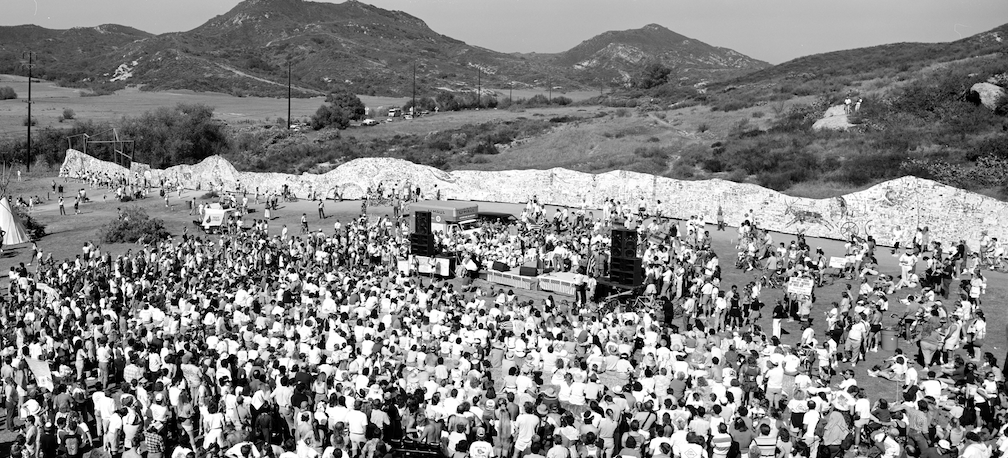
19 Oct Art and Activism: How Environmental Art Projects Helped Save Laguna Beach
“The Walk to Save the Canyon” occurred in Laguna Beach on November 11, 1989. For that happening, 9,000-11,000 people walked four miles from the Laguna Beach Festival of Arts into Laguna Canyon, expressing their desire to preserve that greenbelt. The activities leading to The Walk, the event itself, the subsequent demonstration and the result from these activities — all preventing construction of a massive housing project within the canyon — are legendary tales among long-time Lagunans.
Yet today, while new residents and visitors to Laguna Beach enjoy this area, relatively few know of how numerous artists, environmentalists and activists, working together with passion and unity, helped save Laguna Canyon three decades ago.
Approaching the 31st anniversary of this momentous event, it is more important than ever that we remember what our community has fought for, the value of open space, and the valiant efforts by our artists, writers and thinkers that helped save Laguna Canyon for future generations.
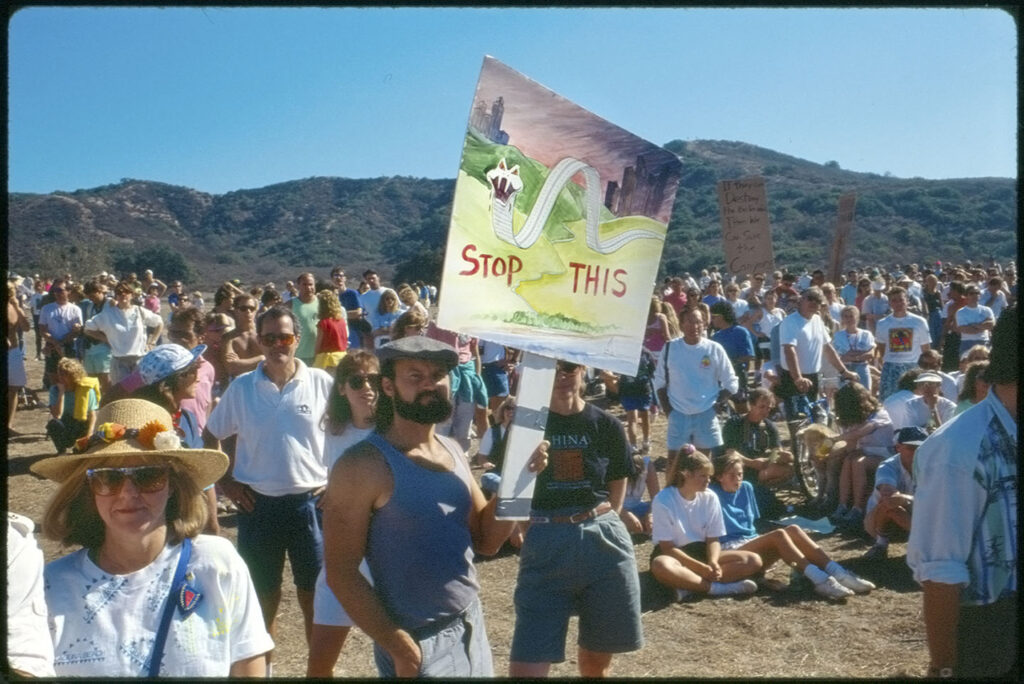
Photographic artists, curators, educators and two men dedicated to art activism—Jerry Burchfield (1947-2009) and Mark Chamberlain (1942-2018)—created the Laguna Canyon Project in 1980. Chamberlain, a prolific writer, described this project in his book, Laguna Canyon Project: Refining Artivism”[i] (published in 2018).
In the spring of 1980, Jerry Burchfield and I agreed to undertake a long-term project, documenting the gateway to our hometown of Laguna Beach, California. Laguna Canyon, with its gently winding two-lane country road was one of the last pristine passages to the Pacific Ocean in Southern California. We hoped to find a means to awaken the public to the dangers of losing that landscape, while challenging their will to save it. We titled this grand ambition ‘The Laguna Canyon Project: The Continuous Document.’
Mike McGee, former Cal State Fullerton art department chairman, also wrote for the Laguna Canyon Project book.
Burchfield, Chamberlain, and a volunteer crew of six kindred spirits set out into the canyon and documented the entire road, or as they sardonically referred to it, ‘the last nine miles of westward migration,’ foot-by-foot, one frame at a time…The project unfolded in a series of phases, documenting and examining the canyon in different methods and increments. They documented it at night, in the daylight, as colorful industrial lights were painting it; they shot it from each side of the road and from a truck with a supporting convoy.
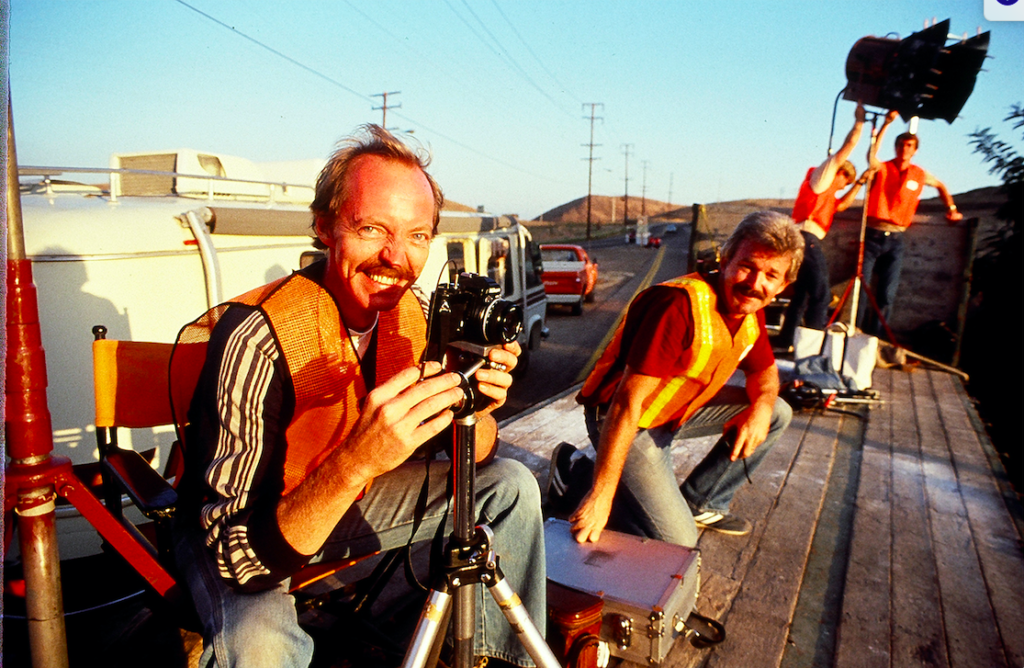
With several phases of the Laguna Canyon Project (1980-2010) as backdrop and stimulus, artists and activists built a giant photographic installation in Laguna Canyon, held many demonstrations and ultimately influenced local and countywide factions to more fully embrace the environmental issues in question. The primary goal of the Project and of allied environmental groups was to save Laguna Canyon — a wide swath of virgin land — by preventing construction of the proposed 3,200-unit Laguna Laurel housing community. Burchfield and Chamberlain, along with local residents Harry Huggins and Charles Michael Murray (discussed below) and numerous other activists helped achieve that goal in 1989.
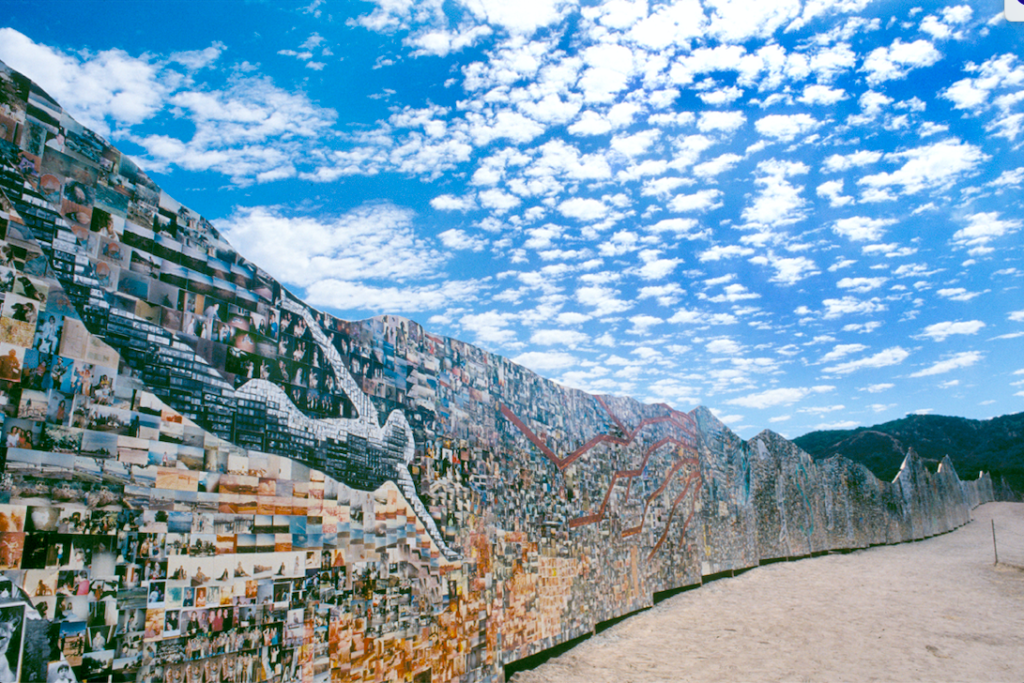
A significant aspect of accomplishing that goal was the creation of The Tell — a 636-foot-long photographic mural, erected in the canyon, in today’s Laguna Coast Wilderness Park. Chamberlain wrote for the Laguna Canyon book: “This enormous mural was comprised of thousands of photographs, depicting all aspects of California life…While this giant installation unfolded from spring to fall in 1989, our initial stalwart supporters swelled into hundreds of volunteers.”
“The Tell captured the life stories of local residents and folded them into a mosaic that spoke of resistance and resiliency. Reflecting the shape of the hills, it became a catalyst in the fight to preserve the land.”

Equally important was “The Walk to Save the Canyon.” Huggins and Murray conceived of The Walk, and brought the concept to the Laguna Canyon Conservancy. They engaged many willing volunteers to help promote it, including celebrities José Feliciano and Bette Midler. On November 11, 1989, an estimated 9,000-to-11,000 volunteers and activists walked four miles from the Festival of Arts grounds eastward to The Tell site where they expressed through speeches and performances their desire and resolve to preserve Laguna Canyon.
A monumental and promising consequence of The Walk, of the subsequent demonstration, and the tremendous press coverage that they generated was that Donald Bren, owner of the Irvine Company and of the canyon land, agreed to sell that land.
The next year, 80 percent of Laguna Beach voters approved taxing themselves $20 million for a bond initiative to buy the canyon land to preserve it as open space into perpetuity. A purchase plan was worked out, and Laguna Canyon is now a key part of the 7,000-acre Laguna Coast Wilderness Park, and of the 22,000-acre South Coast Wilderness area of Orange County.
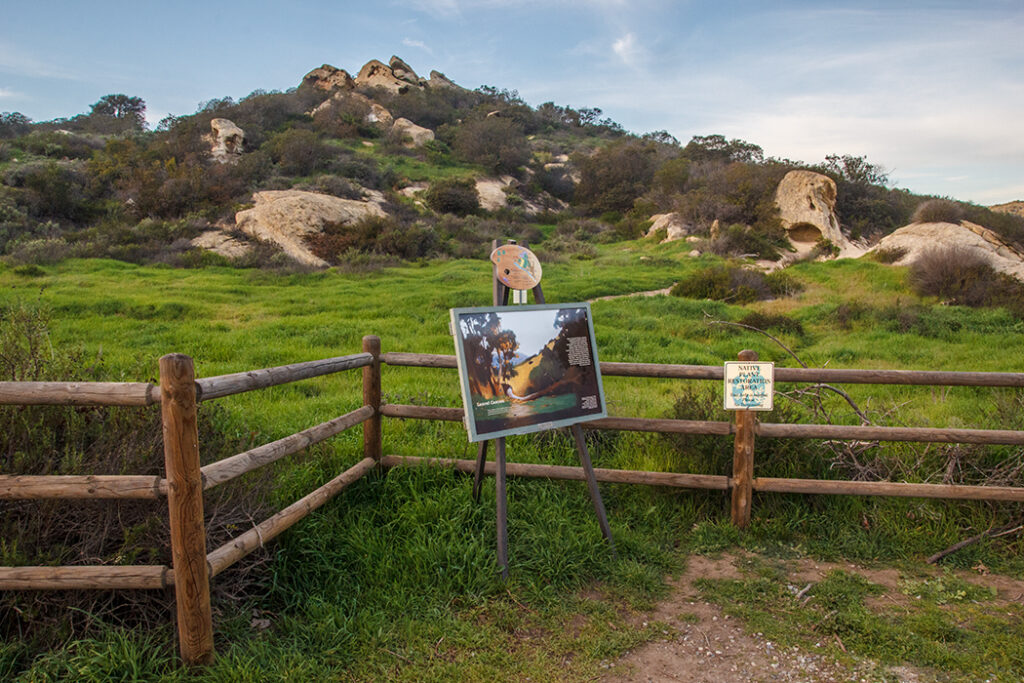
An award-winning article in Laguna Beach Magazine by Richard Chang told the story of the Laguna Canyon Project and The Walk, with reference to a Laguna Art Museum exhibition on the Project (October 18 to January 17, 2016), curated by Mike McGee.
To enlighten generations about the Canyon’s illustrious history, local resident Roger Kempler created a petition requesting a display commemorating Chamberlain and Burchfield’s heroic efforts — to be erected at the site of The Tell. “I believed that people should know about The Tell’s role in helping to preserve this idyllic area amidst the tract homes of Orange County,” he said.
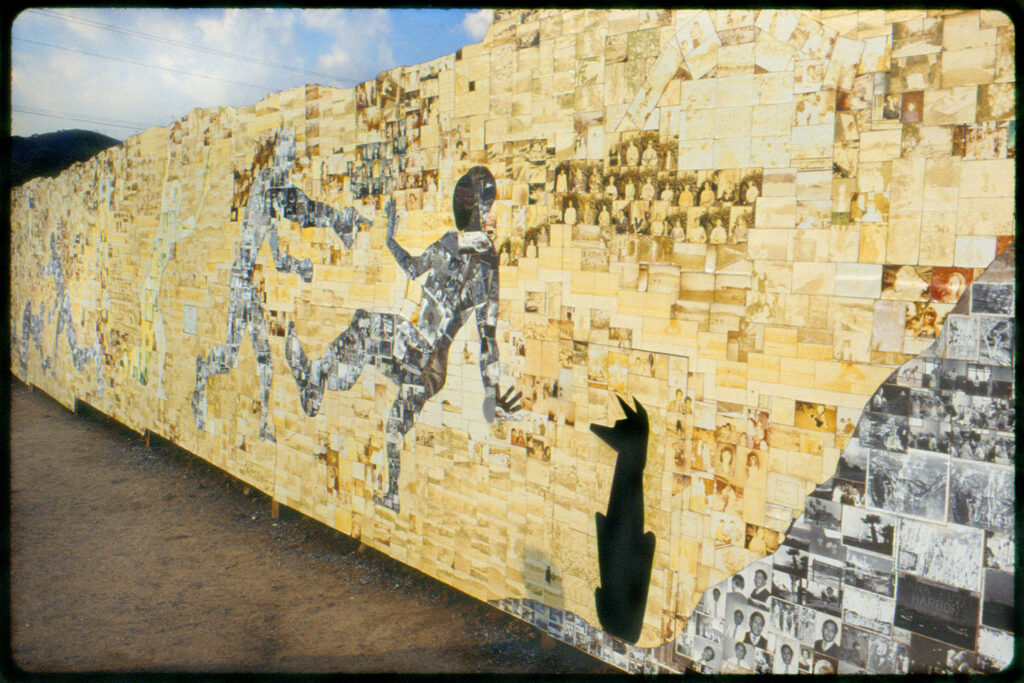
Kempler collected 50 signatures at the BC Space gallery (founded by Burchfield and Chamberlain in Laguna Beach in 1973) Winter Solstice event on December 21, 2018. He then approached County of Orange employees and local citizens to bring the commemorative display to fruition. A committee of interested citizens and county employees along with two consultants was formed to work on the sign design and text.
Part of the approved text reads:
By the 1980s, the call to preserve Laguna Canyon became urgent as development plans were approved. In 1989, a spectacular and massive photographic mural called The Tell was erected nearby this spot. Comprised of over one hundred thousand photographs contributed by the community, The Tell captured the life stories of local residents and folded them into a mosaic that spoke of resistance and resiliency. Reflecting the shape of the hills, it became a catalyst in the fight to preserve the land. The Tell, created by Jerry Burchfield and Mark Chamberlain, spanned 636 feet and reached a height of 34 feet.
“I hope this display of The Tell’s role in helping to save Laguna Canyon is revived, as now the only evidence of the long-dismantled photomural are some post holes out in Sycamore Flats. Yet the mural’s spirit and passion continue to endure.”
A graphic artist was hired to create the visual design; it includes a panoramic photo of the demonstration following The Walk with the vast number of participants there, The Tell in the background and the mountains beyond.
The display was scheduled to be mounted at the original Tell site early this year. But as the installation date grew near, a few committee members asserted that the image and text needed several modifications. Concerned about the cost and time required to further alter the sign, county officials put the project on hold.
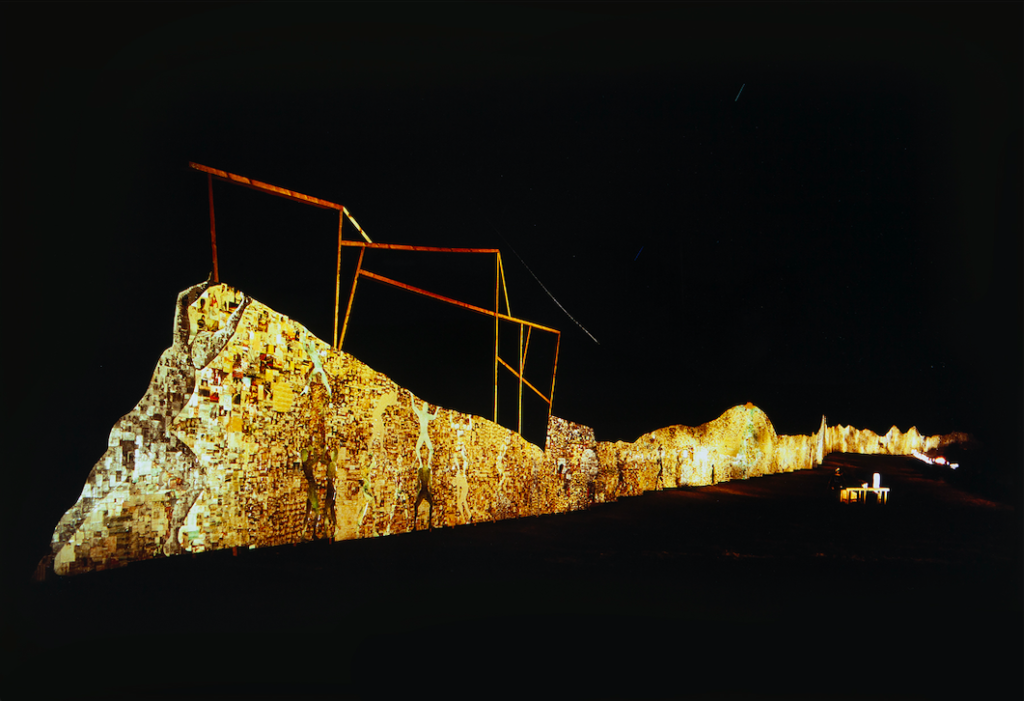
Soon after, the COVID-19 pandemic forced a statewide lockdown. When our lives return to a semblance of normality, a tribute to the power of harmony and community cooperation would be to reawaken the installation project. Or as Kempler says, “I hope this display of The Tell’s role in helping to save Laguna Canyon is revived, as now the only evidence of the long-dismantled photomural are some post holes out in Sycamore Flats. Yet the mural’s spirit and passion continue to endure.”
When The Tell display is finally installed, our community will be able to commemorate the valiant efforts to save Laguna Canyon by the several key players, along with their army of supporters, many of whom are alive and well in Laguna Beach.
[i] Artivism, combining the words art and activism, describes the art-related activist work that Burchfield and Chamberlain pursued throughout most of their adult lives.



Karen Feuer-Schwager
Posted at 10:59h, 19 OctoberBravo, well done. Excited to see the fruition of the projects post project and full recognition.